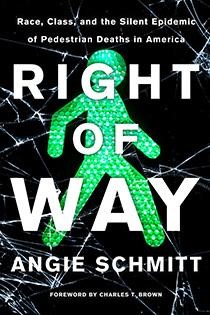Why are walkers and cyclists being killed in such high numbers?
Isabella Scipioni
Pedestrian deaths have skyrocketed over the past decade, and many are wondering what the cause of this crisis is and how to stop it. Of course, distracted driving and other unsafe practices behind the wheel are contributing factors, but Angie Schmitt, the author of “Right of Way,” believes that there are other silent factors at play that many fail to consider.

A Series of Trends
“For the most part, people who are oppressed or have been discriminated against are at higher risk,” said Schmitt on pedestrian deaths.
According to Schmitt, African American, Native American, and Latinx citizens make up a disproportionate amount of pedestrian fatalities, as do older, disabled, or lower-income pedestrians. These communities typically have more dangerous streets with less walkable neighborhoods, shorter traffic signals for pedestrians at crosswalks, and less attention from government officials to make roads safer.
Another trend in pedestrian fatalities is a higher number of deaths in the Sun Belt than any other region. The southern area of the United States stretching from Florida to California has seen an increase in population in recent years but has not seen an increase in infrastructure funding. This area has more dangerous roads, and in turn, more pedestrian deaths.
What is Causing Pedestrian Deaths?
Interestingly, many of the United States’ peer nations have not seen similar rises in pedestrian fatalities. This means that there are either more safety precautions for walkers in other countries or additional dangerous factors leading to higher fatalities in the US. One of those dangerous factors is the prominence of SUVs.
Although definitions differ, SUVs are higher and heavier than average cars, and over the past decade, they have become increasingly popular in the US. Pedestrians struck by sedans or other small vehicles are more likely to get hit in the legs, but SUVs are more likely to hit pedestrians harder and higher in the body, causing damage to internal organs and a greater chance of death. Some SUVs also have forward visibility issues, making it harder for drivers to see pedestrians, especially small children, in front of them.
“If we have vehicles on the road that we know have problems with forward visibility, we should require them to have some safety features. A lot of cars now come with technology like automatic emergency braking, which is a sensor-based braking system, but we haven’t seen the federal government require that,” said Schmitt.
Schmitt believes that regulating SUVs and requiring car manufacturers to conduct more pedestrian-based safety tests would go a long way, but environments outside of the vehicle are still unsafe. Engineers and city planners usually must follow government guidelines when designing roads, walking spaces, and traffic signs and lights. Often, these requirements prioritize drivers over walkers and cyclists, leading to unsafe conditions. Even seemingly simple changes, such as adding a few extra seconds to crosswalk signals for pedestrians to cross, would make a difference. Still, traffic safety advocates face difficulty in getting these less controversial changes made.
Making our roads safer
Although these systemic issues are frustrating, citizens can stand for safer streets by joining public advocacy groups and contacting their government representatives. In an ideal neighborhood, the government and automotive industry would protect the lives of drivers and pedestrians equally. Moving forward, government officials must design streets with ample public transportation and safety precautions for walkers and bikers. The federal government can also pass more regulations for vehicle safety features, especially on heavier and higher cars like SUVs and trucks. Some vehicles already have safety features like emergency braking and crash-avoidance, and requiring these features on vehicles that are a known link to pedestrian fatalities can go a long way in protecting walkers and cyclists.
There are signs of hope. Local advocacy groups in suburban and urban areas are demanding that their cities keep them safe. The recently passed infrastructure bill does include some new safety regulations, but without meaningful societal changes and a changed discourse on accidents, the pedestrian safety crisis is far from over.
Schmitt advises that citizens write to their representatives and demand safer streets, donate time and money to relevant local advocacy groups, and that drivers walk more so that they can step into a frequent pedestrian’s shoes. To end this crisis, we must view pedestrian deaths as preventable tragedies rather than simply as accidents.

Source: Island Press






